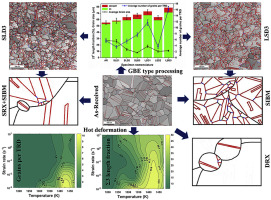当前位置:
X-MOL 学术
›
Acta Mater.
›
论文详情
Our official English website, www.x-mol.net, welcomes your
feedback! (Note: you will need to create a separate account there.)
A critical evaluation on efficacy of recrystallization vs. strain induced boundary migration in achieving grain boundary engineered microstructure in a Ni-base superalloy
Acta Materialia ( IF 8.3 ) Pub Date : 2018-03-01 , DOI: 10.1016/j.actamat.2017.12.045 T.S. Prithiv , P. Bhuyan , S.K. Pradhan , V. Subramanya Sarma , S. Mandal
Acta Materialia ( IF 8.3 ) Pub Date : 2018-03-01 , DOI: 10.1016/j.actamat.2017.12.045 T.S. Prithiv , P. Bhuyan , S.K. Pradhan , V. Subramanya Sarma , S. Mandal

|
Abstract A critical evaluation of recrystallization vs. strain induced boundary migration (SIBM) as the mechanism responsible behind the grain boundary engineering (GBE) in alloy 617 is made. Towards this hot deformation processing (in the temperature range of 1173–1473 K and strain rates of 0.001–10 s−1) as well as GBE-type iterative processing is performed on solution-annealed specimen. GBE-quantifying parameters such as Σ3n fraction, triple junction distribution, twin-related grain size ratio, twin-related domain (TRD) parameters and fractal dimension have been utilized to quantify the extent of GBE in the processed microstructures. Occurrence of dynamic recrystallization (DRX) during hot deformation processing does not induce notable multiple twinning leading to a microstructure analogous to that of solution-annealed condition even after complete DRX. Following GBE-type iterative processing, GBE microstructure has only been achieved when prolific multiple twinning occurred due to activation of SIBM leading to a high fraction of Σ3n boundaries (∼79%) with most of the twins being part of the grain boundary network. Consequently, an increasing proportion of J2 and J3 triple junctions with a concomitant increase in both the average number of grains per TRD and twin-related grain size ratio are achieved. However, occurrence of static recrystallization during GBE-type processing has led to smaller TRD size and copious random boundaries connectivity as confirmed by fractal analysis thus clearly suggesting that SIBM, not recrystallization catalyzes the profusion of Σ3n boundaries. As GBE relies on the multiple twinning mechanisms promoted via SIBM, recrystallization needs to be circumvented for successful attainment of GBE microstructure.
中文翻译:

再结晶与应变诱导边界迁移在实现镍基高温合金晶界工程微观结构中的有效性的关键评估
摘要 对作为 617 合金中晶界工程 (GBE) 背后机制的再结晶与应变诱导边界迁移 (SIBM) 进行了批判性评估。针对这种热变形加工(在 1173-1473 K 的温度范围内和 0.001-10 s-1 的应变速率)以及 GBE 型迭代加工,在固溶退火试样上进行。GBE 量化参数,如 Σ3n 分数、三结分布、孪晶相关晶粒尺寸比、孪晶相关域 (TRD) 参数和分形维数,已被用于量化加工微观结构中 GBE 的程度。即使在完全 DRX 之后,在热变形加工过程中发生动态再结晶 (DRX) 也不会引起显着的多重孪晶,从而导致类似于固溶退火条件的微观结构。在 GBE 类型的迭代处理之后,GBE 微观结构仅在由于 SIBM 的激活导致大量 Σ3n 晶界(~79%)而大量孪晶发生时才实现,其中大部分孪晶是晶界网络的一部分。因此,实现了 J2 和 J3 三重结比例的增加,同时每个 TRD 的平均晶粒数和孪晶相关晶粒尺寸比也随之增加。然而,GBE 型加工过程中静态再结晶的发生导致更小的 TRD 尺寸和丰富的随机边界连通性,如分形分析所证实的那样,因此清楚地表明 SIBM,而不是再结晶催化了大量的 Σ3n 边界。由于 GBE 依赖于通过 SIBM 促进的多种孪生机制,因此需要避免再结晶才能成功获得 GBE 微观结构。
更新日期:2018-03-01
中文翻译:

再结晶与应变诱导边界迁移在实现镍基高温合金晶界工程微观结构中的有效性的关键评估
摘要 对作为 617 合金中晶界工程 (GBE) 背后机制的再结晶与应变诱导边界迁移 (SIBM) 进行了批判性评估。针对这种热变形加工(在 1173-1473 K 的温度范围内和 0.001-10 s-1 的应变速率)以及 GBE 型迭代加工,在固溶退火试样上进行。GBE 量化参数,如 Σ3n 分数、三结分布、孪晶相关晶粒尺寸比、孪晶相关域 (TRD) 参数和分形维数,已被用于量化加工微观结构中 GBE 的程度。即使在完全 DRX 之后,在热变形加工过程中发生动态再结晶 (DRX) 也不会引起显着的多重孪晶,从而导致类似于固溶退火条件的微观结构。在 GBE 类型的迭代处理之后,GBE 微观结构仅在由于 SIBM 的激活导致大量 Σ3n 晶界(~79%)而大量孪晶发生时才实现,其中大部分孪晶是晶界网络的一部分。因此,实现了 J2 和 J3 三重结比例的增加,同时每个 TRD 的平均晶粒数和孪晶相关晶粒尺寸比也随之增加。然而,GBE 型加工过程中静态再结晶的发生导致更小的 TRD 尺寸和丰富的随机边界连通性,如分形分析所证实的那样,因此清楚地表明 SIBM,而不是再结晶催化了大量的 Σ3n 边界。由于 GBE 依赖于通过 SIBM 促进的多种孪生机制,因此需要避免再结晶才能成功获得 GBE 微观结构。











































 京公网安备 11010802027423号
京公网安备 11010802027423号